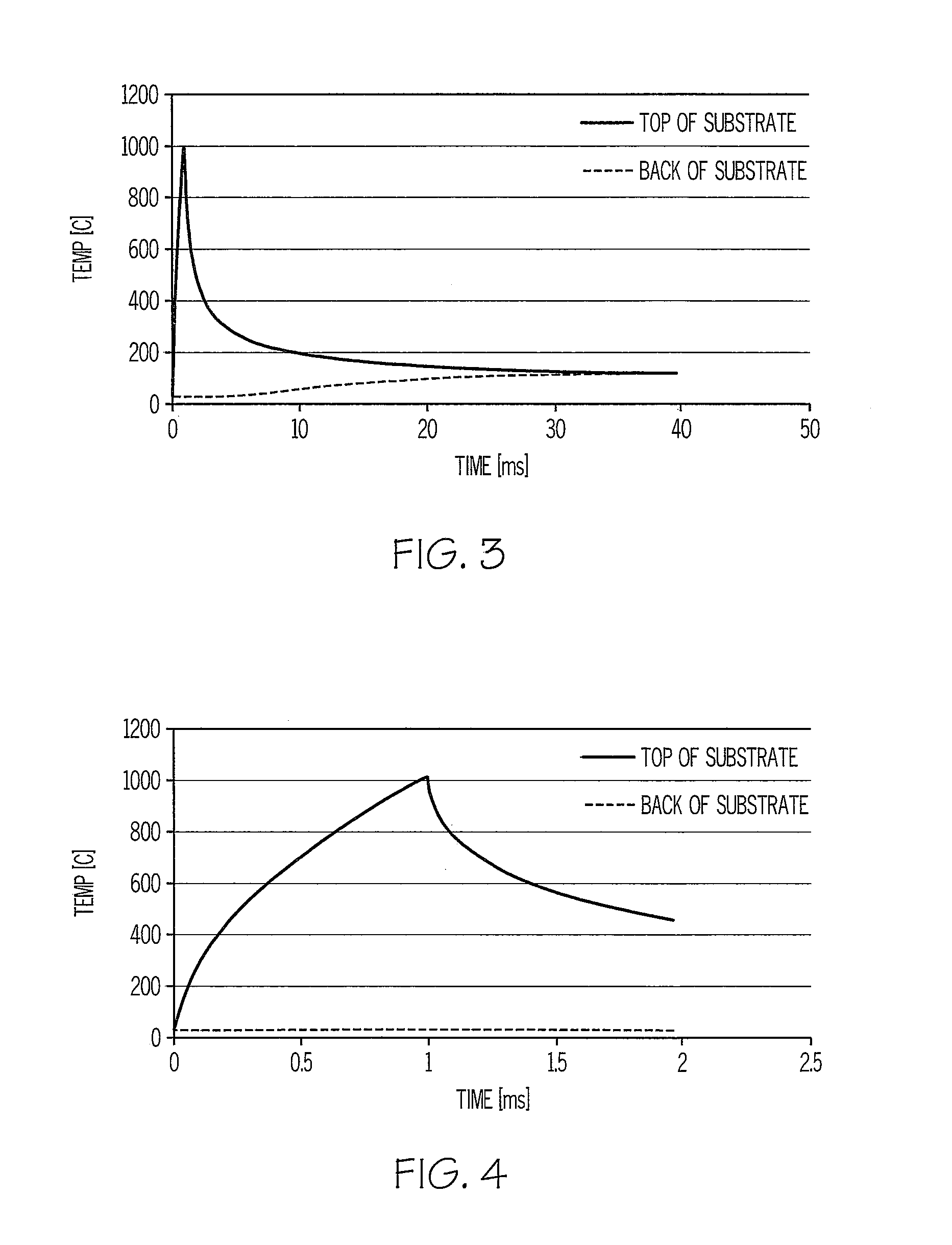Apparatus for providing transient thermal profile processing on a moving substrate
a technology of thermal profile and apparatus, which is applied in the direction of lighting and heating apparatus, drying machines with progressive movements, furnaces, etc., can solve the problems of increasing cost by reducing throughput, film materials require a higher level of thermal processing that is not compatible with low-temperature substrates, and the thermal processing of thin films is often limited by the properties of substrates, so as to avoid damage to materials
- Summary
- Abstract
- Description
- Claims
- Application Information
AI Technical Summary
Benefits of technology
Problems solved by technology
Method used
Image
Examples
example 1
Rapid Drying of a Thin Film on 150 Micron Thick PET
[0041]A rapidly pulsed heating source with sufficient intensity can dry a thin film on a low temperature substrate in a non-destructive manner much faster than a continuous source. When the individual pulses of FIG. 4 are broken up into the multiple pulses of FIG. 5, the thin film is allowed to breathe during the rapid heating process, thereby preventing a cohesive failure of the film while still drying the film very rapidly. In the context of the present invention, “breathe” means to allow adequate time for non-destructive convective transport of evolved gasses. The shaped pulses can be synchronized to a moving web as in FIG. 6.
[0042]Note that this has a very different effect than a continuous train of rapid small pulses. In that case, the surface does not reach the peak temperatures achieved in the present invention. Consequently, it has a lower processing rate, and the bulk of the substrate is preferentially heated over the prese...
example 2
Temperature Control at the Surface of a Polymer Substrate
[0043]FIG. 7 shows a thermal profile of the same thermal stack as in FIG. 5. The peak temperature achieved and the envelope pulse length are identical in the two cases. However, in FIG. 7 the ramp-up rate is much faster, and the peak temperature is maintained for the duration of the pulse. When this is done, 12% more energy can be delivered to the thin film within the same 1 ms interval. When sintering a metal ink to form a conductor, this small improvement can translate into a doubling of the conductivity of the thin film. This is done by adjusting the duration and delay of each individual micropulse in the shaped pulse Since the surface of the thin film still only reaches 1,000° C., this curing profile results in a better cure of the thin film without damaging the fragile substrate.
[0044]FIG. 8 shows a thermal profile of a more complex waveform in which a thin film is heated on the surface of a polyimide substrate. The wavef...
example 3
Prevention of Cohesive Failure in a Thin Film by Modulation of Gas Generation
[0045]An aqueous copper precursor ink was formulated comprising 10.0% wt. copper (II) oxide, 4.5% wt. copper (II) acetate in a base containing ethylene glycol and glycerol. Traces were printed onto a 125 micron thick PET sheet using an Epson Stylus C88 ink jet printer. Upon curing with a flashlamp, the copper oxide and copper acetate are reduced by the ethylene glycol and glycerol to form a film of conductive copper metal. The reduction reaction generates a moderate amount of gas.
[0046]The printed film was cured using the present invention with the following conditions: voltage 250 V, pulse envelope duration=1,050 microseconds, 4 micropulses with a duty cycle of 0.6 (i.e., each micropulse was 175 microsecond long with a delay of 117 microseconds between pulses), overlap factor=3, web speed=6.4 meters / min. The sample yield was 100% with an average sheet resistance of 3.7 Ω / square.
[0047]When the identical tra...
PUM
| Property | Measurement | Unit |
|---|---|---|
| Temperature | aaaaa | aaaaa |
| Power | aaaaa | aaaaa |
| Width | aaaaa | aaaaa |
Abstract
Description
Claims
Application Information
 Login to View More
Login to View More - R&D
- Intellectual Property
- Life Sciences
- Materials
- Tech Scout
- Unparalleled Data Quality
- Higher Quality Content
- 60% Fewer Hallucinations
Browse by: Latest US Patents, China's latest patents, Technical Efficacy Thesaurus, Application Domain, Technology Topic, Popular Technical Reports.
© 2025 PatSnap. All rights reserved.Legal|Privacy policy|Modern Slavery Act Transparency Statement|Sitemap|About US| Contact US: help@patsnap.com



